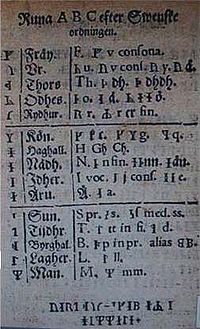
Runa ABC
Encyclopedia

Johannes Bureus
Johannes Thomae Bureus Agrivillensis was a Swedish antiquarian, polymath and mystic. He was royal librarian, tutor, and adviser of King Gustavus Adolphus of Sweden....
was the first Swedish alphabet book
Alphabet book
An Alphabet book is a book primarily designed for young children. It presents letters of the alphabet with corresponding words and/or images. Some alphabet books feature capitals and lower case letter forms, keywords beginning with specific letters, or illustrations of keywords...
and its purpose was to teach the runic alphabet
Runic alphabet
The runic alphabets are a set of related alphabets using letters known as runes to write various Germanic languages before the adoption of the Latin alphabet and for specialized purposes thereafter...
in 17th century Sweden.
The runology
Runology
Runology is the study of the Runic alphabets, Runic inscriptions and their history. Runology forms a specialized branch of Germanic linguistics.-History:...
pioneer Johannes Bureus
Johannes Bureus
Johannes Thomae Bureus Agrivillensis was a Swedish antiquarian, polymath and mystic. He was royal librarian, tutor, and adviser of King Gustavus Adolphus of Sweden....
was a religious Christian, but he also thought that the Christian influence had replaced the runic alphabet
Runic alphabet
The runic alphabets are a set of related alphabets using letters known as runes to write various Germanic languages before the adoption of the Latin alphabet and for specialized purposes thereafter...
with the Latin alphabet
Latin alphabet
The Latin alphabet, also called the Roman alphabet, is the most recognized alphabet used in the world today. It evolved from a western variety of the Greek alphabet called the Cumaean alphabet, which was adopted and modified by the Etruscans who ruled early Rome...
. His good reputation and his influential friends enabled him to acquire the royal privilege that no alphabet books could be printed without teaching the runic alphabet and no one was allowed to print them but himself. The result was that the first Swedish alphabet book ever printed had the purpose of teaching runes.
The first edition of Runa ABC was printed in 1611. It contained the Latin alphabet in ABC order and the runic alphabet in both the futhark order and in the order of the Latin alphabet. Bureus had also added the names of the runes, the phonemes they represented as well as some spelling rules. The booklet contained small Christian texts, which were written in runes on one side and in Latin letters on the opposite one. The last edition was printed in 1624, and it was more pedagogical than the first one, since the Latin letters were placed directly under the runes. Whereas the first edition ended with some prayers written in Latin letters, the 1624 edition had the final prayers written with runes, without any Latin transliteration.
Bureus did not succeed in making the runes replace the Latin alphabet since people were too familiar with the Latin letters. However, during the Thirty Years' War
Thirty Years' War
The Thirty Years' War was fought primarily in what is now Germany, and at various points involved most countries in Europe. It was one of the most destructive conflicts in European history....
, some Swedish officers encrypted their messages by writing with runes.
Lars Magnar Enoksen notes that it appears from the title page of Johannes Bureus' first edition that Bureus had some understanding of the staveless runes
Staveless runes
Staveless runes were the climax of the simplification process in the evolution of runic alphabets that had started when the Elder Futhark was superseded by the Younger Futhark. In order to create the staveless runes, vertical marks were dropped from individual letters...
in 1611, but that this has been denied by virtually all runologists.
External links
- Runa ABC as a digital facsimile

